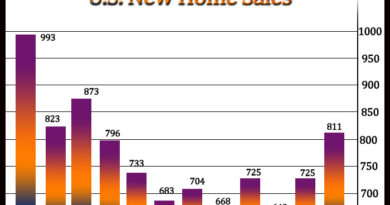Bank Of England Lifts Rate To 13-year High On Inflation Fears
Despite weak growth prospects, the Bank of England decided to hike its key rate by a quarter-point to a 13-year high as policymakers try to bring inflation, which is now expected to peak above 10 percent this year, back to the target.
The nine-member Monetary Policy Committee, led by Governor Andrew Bailey, raised the key bank rate to 1.00 percent from 0.75 percent, in a split vote.
Six members of the Monetary Policy Committee, including Bailey, voted to lift the bank rate by 25 basis points, while other three members sought a 50 basis-point increase to 1.25 percent.
At the previous meeting in March, there was only one dissenting member Jon Cunliffe who voted to keep the rate unchanged.
A cumulative 90 basis points hike over the past four consecutive meetings has taken the bank rate from a historic low of 0.1 percent to the current 1.00 percent, the highest since early 2009.
Most MPC members judged that some degree of further tightening in monetary policy may still be appropriate in the coming months.
“The MPC will continue to review developments in the light of incoming data and their implications for medium-term inflation,” the bank said.
The MPC will consider whether to sell government bonds held under the asset purchase programme, but no such decision will be taken before the August meeting.
In response to questions from reporters, Bailey said BoE policymakers disagree with those who believe interest rates must be raised much higher.
The BoE announcement came after the U.S. Federal Reserve had raised its key rate by 50 basis points on Wednesday.
Amid fears of stagflation and the recession warning from the BoE, the British pound plunged to a near two-year low against the US dollar.
The BoE expects inflation to peak later in the United Kingdom than in many other economies, and may therefore fall back later.
Due to the war in Ukraine and the Covid-19 lockdown in China, CPI inflation was expected to rise to around 9 percent in April, and to increase further in subsequent months, averaging slightly over 10 percent at its peak in the fourth quarter of 2022.
However, CPI inflation is projected to fall to a little above the 2 percent target in two years’ time as the causes of the current high inflation are unlikely to persist.
Although the economy has been recovering from the effects of Covid, the increased cost of living is set to lead to slower growth overall. The bank expects a recession next year due to drags from higher inflation and rising interest rates.
GDP is estimated to have risen by 0.9 percent in the first quarter of 2022, stronger than expected in the February Monetary Policy Report. But the level of GDP is expected to be broadly unchanged in the second quarter.
The projections are based on the assumption that the Bank Rate will rise to around 2.5 percent by mid-2023, before falling to 2.00 percent at the end of the forecast period.
A tight labor market and sticky price/wage expectations will mean that domestic price pressures stay stronger for longer than the MPC expects, Capital Economics economist Paul Dales said.
Accordingly, despite weaker GDP growth, the MPC will raise rates by 25 bps at each meeting this year and to 3.00 percent in 2023, the economist added.
Nonetheless, ING economist James Smith said the new forecasts, taken together with the increasing division among committee members, suggest the bank is getting closer to a pause in its tightening cycle.
Source: Read Full Article


